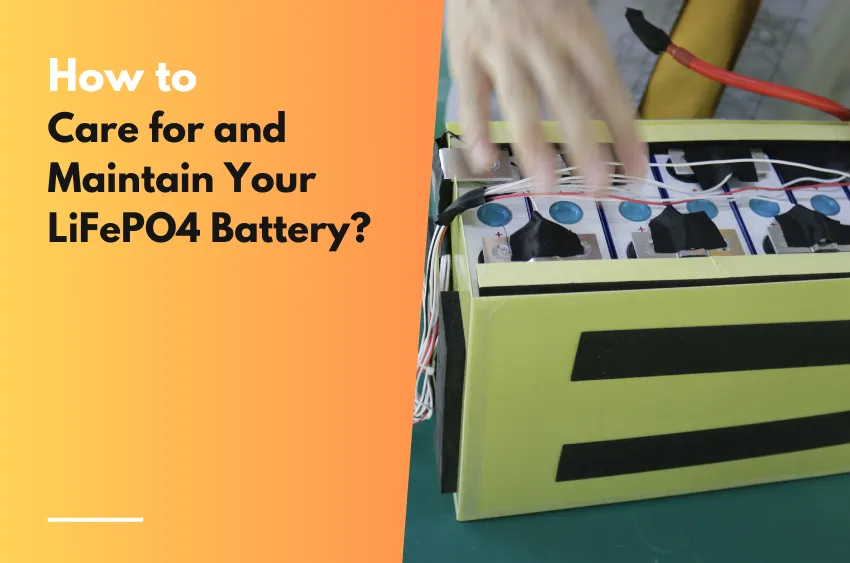LiFePO4 batteries are a type of lithium-ion battery that use lithium iron phosphate as the cathode material. They have several advantages over other lithium battery types, such as longer cycle life, lower cost, higher safety, and lower environmental impact. LiFePO4 batteries are suitable for various applications, such as backup power, marine, RV, and camping. However, LiFePO4 batteries also require proper care and maintenance to maximize their performance and lifespan.

In this article, we will describe the proper way to charge, discharge, and store your LiFePO4 battery, warn about some of the common mistakes and myths that can damage your LiFePO4 battery, advise on how to monitor and test your LiFePO4 battery’s health and capacity, and explain how to troubleshoot and fix some of the common problems and issues that may arise with your LiFePO4 battery.
The way you charge, discharge, and store your LiFePO4 battery can affect its performance and lifespan. Here are some tips and best practices on how to charge, discharge, and store your LiFePO4 battery:
How to charge your LiFePO4 battery: To charge your LiFePO4 battery, you need to use a compatible charger that can deliver the appropriate voltage and current to the battery. You also need to follow the manufacturer’s instructions and recommendations on the charging process and parameters. Generally, you should charge your LiFePO4 battery at a constant current (CC) until the battery reaches its fully charged voltage, then switch to a constant voltage (CV) until the current drops to a low level, and then stop the charging. You should avoid overcharging your LiFePO4 battery, as it can reduce its capacity and lifespan. You should also avoid charging your LiFePO4 battery in extreme temperatures, as it can affect its performance and safety. Ideally, you should charge your LiFePO4 battery in a cool and dry place, between 0°C and 45°C.
How to discharge your LiFePO4 battery: To discharge your LiFePO4 battery, you need to connect it to a device or system that can draw the required power and energy from the battery. You also need to follow the manufacturer’s instructions and recommendations on the discharge process and parameters. Generally, you should discharge your LiFePO4 battery at a moderate rate, and avoid deep discharging your LiFePO4 battery, as it can damage the cells and shorten the lifespan. You should also avoid discharging your LiFePO4 battery in extreme temperatures, as it can affect its performance and safety. Ideally, you should discharge your LiFePO4 battery in a cool and dry place, between -20°C and 60°C.
How to store your LiFePO4 battery: To store your LiFePO4 battery, you need to keep it in a state of partial charge, between 40% and 80% of its capacity. You also need to follow the manufacturer’s instructions and recommendations on the storage conditions and duration. Generally, you should store your LiFePO4 battery in a cool and dry place, away from heat, moisture, and direct sunlight. You should also avoid storing your LiFePO4 battery in a fully charged or fully discharged state, as it can cause irreversible capacity loss and internal resistance increase. You should also check and recharge your LiFePO4 battery periodically, at least once every six months, to prevent self-discharge and cell imbalance.
There are some common mistakes and myths that can damage your LiFePO4 battery, and you should avoid them. Here are some of them:
Mistake: Using an incompatible charger: Using an incompatible charger can damage your LiFePO4 battery, as it can deliver the wrong voltage and current to the battery, and cause overcharging, undercharging, or short circuit. You should always use a compatible charger that matches the specifications and the requirements of your LiFePO4 battery, and follow the manufacturer’s instructions and recommendations on the charging process and parameters.
Myth: LiFePO4 batteries have memory effect: Memory effect is a phenomenon that occurs in some rechargeable batteries, such as nickel-cadmium (NiCd) and nickel-metal hydride (NiMH) batteries, where the battery loses its capacity and performance if it is repeatedly charged and discharged to the same level. However, LiFePO4 batteries do not have memory effect, and they can be charged and discharged at any level, without affecting their capacity and performance. You do not need to fully charge or fully discharge your LiFePO4 battery, and you can charge or discharge it at any time, without worrying about memory effect.
Mistake: Freezing your LiFePO4 battery: Freezing your LiFePO4 battery can damage your LiFePO4 battery, as it can cause the electrolyte to freeze and expand, and crack the cells and the casing. You should avoid freezing your LiFePO4 battery, and keep it in a cool and dry place, between -20°C and 60°C. You should also avoid charging or discharging your LiFePO4 battery in freezing temperatures, as it can affect its performance and safety.